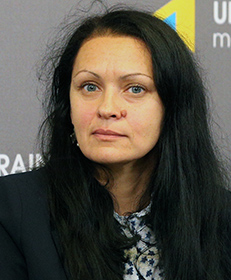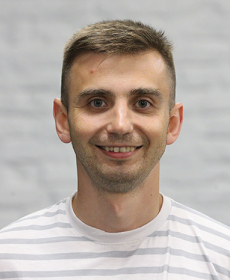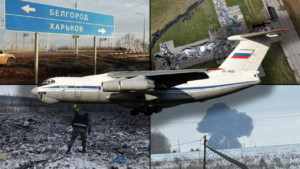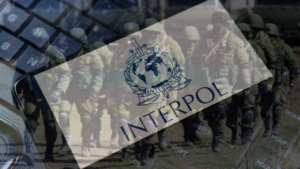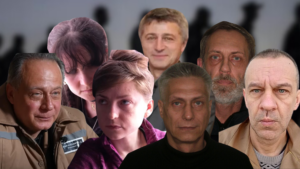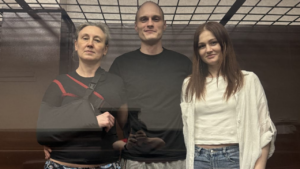War Crime in Olenivka: Investigation into the Events Related to the Massacre of Imprisoned Azov Regiment Soldiers
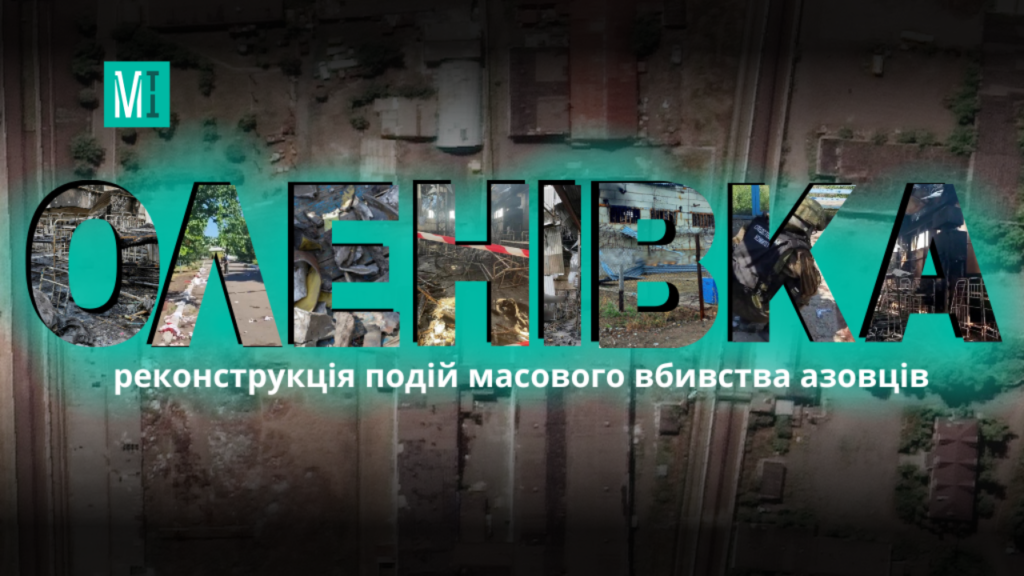
A year ago, during the night of July 28-29, several explosions rocked Volnovakha Penal Colony No. 120, known as Olenivska. A fire broke out in a barrack where 193 Azov Regiment soldiers were imprisoned. About 50 soldiers were killed then, and more than 70 were gravely injured. The Media Initiative for Human Rights is conducting its own investigation into the crime. This time, we will closely focus on the events that took place on July 28-29, 2022.
All the circumstances of what happened in Olenivka have not been established to this day. The names of those who organized and committed the crime have not been revealed. The case is investigated by the Security Service of Ukraine and Prosecutor General’s Office. The biggest problem lies in that detectives do not have access to the crime scene, most of the witnesses are still kept in captivity, and the faces of persons potentially involved in the murder were hidden by masks.
Relatives of wounded and dead servicemen of the separate special purpose unit “Azov” of the National Guard of Ukraine and some of the soldiers of this unit released from captivity believe that the investigation is progressing slowly. Over this period of time, evidence has been lost, and witnesses have been killed. So there is a risk that the perpetrators will go unpunished.
Earlier, MIHR identified potential participants in the Olenivka crime. In this article, we will focus on the events that took place on July 28-29, 2022.
Getting out of one hell to get into another one
“We were waiting for him so much. My daughter burst into tears when, at three o’clock in the morning, she realized that her dad would not come back. He should have been exchanged in September 2022, if he had survived,” says Svitlana Solonska, the wife of Vladyslav Solonskyi, the member of the Azov Regiment.
In 2014, her husband volunteered for service in the Azov Regiment immediately after the Revolution of Dignity.
“At first, Vladyslav went to the Military Commissariat. But he was not accepted into the army because of his back injury he had received before. Then his friend and business partner from Berdiansk said that he could get recruited into the Azov Regiment in Urzuf. He decided to enlist,” recalls Svitlana.

Azov Regiment soldier Vladyslav Solonskyi
At first he worked as a driver, later he became a platoon commander, a company commander. In a year, he became an assistant to the deputy commander in charge of logistics support. He is one of those who organized the logistics support for the Azov Regiment, restored and built a training camp. He served to become a logistics officer. He signed the contract in 2015. He got the nickname ‘Osyp’ because he was born and lived near Berdiansk in the village of Osypenko.
February 22, 2022, was the last time when Svitlana saw Vladyslav.
He called in and said that he would be transferred to Zaporizhzhia. I asked, “How?” “Everything will be OK,” he answered. But someone called and he said, “No, not to Zaporizhzhia, but to Mariupol.” He frowned. I hugged him. He really wanted to see Sonia, our 14-year-old daughter, but she had decided to visit her friend on her way from school. He was upset.”
In March, Solonskyi was at Azovstal in Mariupol.
“I remember how he once said to me that the city no longer existed,” recalls Svitlana. “I did not believe it.
Although we ourselves were under occupation. Russian vehicles moved through Osypenko to Mariupol day and night. No one stopped them. My husband said, “Let them go. We are waiting for them here.”
Then he sent photos of the ruins. He said that they were shelled from the sea during the day, and from airplanes at night. And every time he would ask to leave the occupied territory.”
In the end, Svitlana and her daughter Sofiia managed to leave for Poland.
“There, news about Azovstal flooded the media landscape. I went to work in Poland and heard endless talks about it on the radio. Sonia visited a psychologist in Poland. When she found out that our father was at Azovstal, she burst into tears. Then they called for unblocking at Eurovision. Can you imagine how hopeful we were?! I would ask my husband in an SMS message, “Vladyslav, when will they run out of their bombs?” He would sent smiles. Some of the experts claimed that it was impossible to break through Azovstal. Why is it impossible, when everything turned out to be possible?
It got worse every time. Vladyslav wrote, “Our guys do amazing things here. They are so good, real heroes.” Then he said that boys and girls were dying. And once he told me to hold on, as I should live on to see my grandchildren.”
Military actions on the premises of the Azovstal Iron and Steel Works lasted from mid-March to May 20, 2022. A complex network of underground tunnels turned Azovstal into a fortress. However, Russian troops were getting closer and closer, the fire was getting heavier, and ammunitions, food, water, and most importantly, human resources were running out quickly, so it became increasingly difficult to hold the defense line.
In mid-May, Svitlana learned that Azov Regiment soldiers would surrender.
“Honourable surrender. That is what he wrote,” says Solonska. “They all were sure that the conditions of detention would be appropriate, the Red Cross would record every last name, so nothing would happen to anyone, and, in three or four months, they would all be exchanged according to the Geneva Conventions and in accordance with the agreements reached.”
The defense of the city lasted for 86 days. The city was completely surrounded for 82 days. In mid-May 2022, the top leadership of Ukraine made a decision to “evacuate” all military personnel who stayed on the premises of Azovstal. They referred to agreements with the Russian Federation, noting that it was done to preserve lives of the defenders. Thus, the last defenders of Mariupol, a total of about 2.5 thousand Ukrainian soldiers, including Azov Regiments members, surrendered on May 20, 2022. Most of them ended up at Volnovakha Colony No. 120.

Olenivka Colony on the map
“In the evening, we arrived at Olenivka, stopped near the walls, and were allowed to go to the toilet. We spent the night in those buses, and in the morning we drove into the territory of the colony. They started to take us out. They ordered to strip naked and squat down. They thoroughly checked everything, removed the laces, cut the straps. Some things were taken away, some things were left,” recalls a soldier of the Azov Regiment with the call sign ‘Lemko’.
Two barracks (9/10 and 1/2), located in the far left corner of the colony, were assigned to Azov Regiment soldiers.

Satellite image of the Olenivka Colony barracks
There were neither beds nor mattresses inside. We slept on the floor. If you are lucky, they let you have a ground pad. Some of the prisoners of war slept on the street near the barracks – there was not enough room to accommodate everyone.
A few prisoners managed to keep their mobile phones, so we had occasional and very short contacts with the outside world.
“On July 26, Vladyslav sent me the last SMS message: “Everything is OK. I live for you. I love you infinitely. Hug you tightly. Cannot wait to meet you.” And then I saw a video on one of the Russian channels, where my husband was standing in the square. It was shortly before the news about the explosion in Olenivka.
We didn’t believe it at first. We thought it was a fake. Then we saw dead Azov Regiment soldiers. After some time, the Ministry of Defense of the Russian Federation published lists of the dead and wounded. Vladyslav Solonskyi was number 66 on the list of those wounded,” recalls Svitlana Solonska.
Barracks “200”
“The barracks hit by the explosion was nestled within the industrial zone, segregated from the remainder of the penal colony. Initially, none of the Azov fighters had any knowledge of it – its purpose was not for the detention of prisoners of war. The industrial zone was situated on the right flank of the colony.

A map depicting the Olenivka colony
In the early days of July 2022, a transformation began in one of the structures within the industrial zone. According to former prisoners, speculations proliferated rapidly within Olenivka, thus generating theories about the future function of the nascent barracks. Some suggested it would accommodate Russian military personnel, others theorized that it was being readied for Ukrainian prisoners due for exchange. Subsequently, information surfaced indicating a transfer of several hundred Azov fighters to a penal colony in Horlivka.
On July 26, guards with lists in their hands arrived in the Azov barracks. A member of the DPR, known by the moniker “Third”, recited the lists aloud. Witnesses indicate he was a defected Ukrainian soldier who had renounced his oath. Some of the former prisoners of war, interviewed by the MIHR, label him as the overseer of the colony’s Disciplinary Isolation Unit (DIU).”
“We were aware that in Horlivka all our possessions would be confiscated, so we decided to leave our items with the comrades,” says an Azov soldier known by the call sign Lemko. He insists that at the moment they were summoned via the list, none of them understood the rationale behind it: “We were even joking around in the barracks: ‘Can you imagine, we’re getting sent to the industrial zone.’ And all of a sudden we indeed found ourselves in the industrial zone.”
Among those whose names were on the list were members from various Azov units, both rank-and-file soldiers and officers. It remains an enigma who made the selection and by what criteria, but the roster included exclusively Azov personnel, with no inclusion of representatives from other military divisions.
“It was sheer randomness,” says an Azov soldier going by the call sign Hasan, a medic. “There were people from every Azov division. Later, we pondered about the logic behind our targeted elimination. It is unclear. Everyone was present – ranging from members of the canteen staff and medical team to Lieutenant Colonel Dmytro Bukaryov, the deputy commander of the separate special forces unit of Azov responsible for artillery deployment. There were even members of the anti-aircraft missile division.”
“As soon as we were brought there, we promptly took a pen and conducted a headcount of all the personnel. 198 people. Five were transferred to the Donetsk pretrial detention center the same day – members of the anti-aircraft defense force were taken away. A total of 193 of us remained,” the soldier recounts, glancing at a photo showing a chalkboard with numbers on it. “You won’t believe it, but I wrote it. My mother recognized it later from my handwriting,” another soldier interjects.

A chalkboard where the Azov soldiers documented the headcount in the barracks
Vladyslav Solonskyi also found himself in the industrial zone barracks.
Inside the hastily converted barracks, previously a metalworking shop, were bunk beds. Mattresses and pillows were supplied later. The barracks was readied in a rush, and a few days before the Azov soldiers were transferred there, barbed wire was added to the fencing. The guards also dug trenches near the barracks.
The barracks was a capacious space, unfit for habitation. It was roughly partitioned into two sections. The first one was adjacent to the entrance. It was a metallic extension featuring a makeshift kitchen. A substantial and hefty iron gate led to the second section. Behind this gate was a workshop with walls constructed of concrete blocks. Overhead was a metal roofing. The room housed presses and machines. The windows were located high up and did not open. The soldiers recount that on the first day they requested the removal of the glass to facilitate easier breathing, but this request was denied.

The exterior view of the barracks where the Azov soldiers met their demise
The bunk beds were packed tightly throughout the barracks, making it extremely challenging to navigate between the rows. Almost immediately upon arrival, the Azov soldiers embarked on a full inspection of the entire area, scrutinizing every corner.
To the left of the entrance, as is customary in workshops, there was a two-room booth for the chief engineer situated under the ceiling. A staircase led to it. At first, the Azov fighters considered using it as an additional sleeping area, but later decided to reserve it as a meeting room. It was in this space that the prisoners congregated on the afternoon of July 28, on the eve of the attack, deliberating when to end the day, switch off the lights, and retire to bed. “Some wanted the cutoff time to be at 10 pm, others at 11 pm. We settled on 22:30. On July 28, comrade Bronya went to turn off the lights, I remember that distinctly,” Lemko recollected.
The man recalls that after this, he conversed with the day watchman, who was positioned outside the barracks gate near a board with numbers: “We stood and talked. As the senior officer in the barracks, I had to make my rounds. I retired to bed at around 11:15 pm.”
The soldiers remark that on the preceding night, the guards mandated everyone to vacate the perimeter, prohibiting them from staying outside overnight.
“In the evening, we held a general roll call – right here,” he says, indicating the area to the left of the barrack entrance in a photo.
Every individual was ushered inside by name to confirm everyone’s presence. We were instructed that not even restroom breaks were permitted. And in case of dire necessity, it would be one person at a time.
A man with the call sign Okhotnik was present. He was invariably there during instances when prisoners were being transported for interrogation, relocated to a different colony, or transferred for exchange,” says one of the Azov fighters. Subsequently, everyone was locked up inside the space for the night.
Three explosions and an ensuing fire
Around 23:30 on July 28, the initial explosion happened. Something crashed outside the colony’s perimeter.
“I was still awake. The flash was remarkably prolonged. I inspected the windows for damage. They were intact,” Lemko recounts.
Hasan also stirred from his sleep due to the explosion: “Because the explosion occurred exceptionally close. A comrade with the call sign Kipish, a cook, ventured out to investigate what had happened. His curiosity was piqued. I, however, was not intrigued and fell back asleep.”
It is noteworthy that the Russians had positioned their military equipment almost flush with the penal colony’s territory. “We kept hearing Maryinka: the sound of airplanes, artillery. We had a so-called ‘TV set’ in Barracks 9 – from the room’s windows, we could watch the artillery fire. There were Grads (122 mm multiple rocket launcher systems – MIHR) and Solntsepyok systems (Russian 220 mm multiple rocket launcher system – MIHR) in close proximity. The Grads were firing almost daily. And periodically, our forces struck them. It was a remarkable sight,” Hasan says.
Then, a second explosion ensued, this time within the barracks, which happened approximately at 23:45.
Lemko recalls jolting awake, his body aflame and bloodied.
“Flames were everywhere, roof tiles were dangling downward. A portion of the roof crashed onto my bed, which was situated more or less in the center of the barracks. I understood that I had sustained minor burns, in addition to a multitude of shrapnel injuries,” he says.
Lemko didn’t witness the instant of the explosion. The explosion was observed by Kyrylo Masalitin, call sign Maslo, who recounts being in his bunk on the second tier at the time. “There were three explosions. The first one roused me. Somewhere beyond our territory, the Grads initiated their operation, which was a frequent occurrence. I sprang out of bed and tried to comprehend what was unfolding. I was glancing towards the hangar’s exit when the second explosion happened. And as I was standing there, confounded and unable to decipher what was happening, a third explosion struck. The blast wave knocked me off my feet and I toppled under the bed,” says Kyrylo Masalitin.
Lemko carries on:
“I began extricating myself from the bed. There was a body beneath my feet. My comrades were laying lifeless on the first tier. Comrade Bashnya was somewhere under my feet. I checked for a pulse on his neck, finding nothing. The body was intact. I started dragging him out. We succeeded in pulling him out a bit. A fighter lay on the side, howling. We began pulling out the one who was still alive. The fire was now intense, and I began losing consciousness due to the blood loss.”
“After the first explosion within the barracks, I was hurled to the neighboring bed, my teeth knocked out. I opened my eyes and found myself sprawled somewhere below,” Hasan recalls. His bed was also situated in a section of the barracks distant from the entrance.
Hasan narrates that he instantly darted towards the exit: “I spotted the collapsed beds. Most of them were displaced by the blast wave. I felt something similar to engine oil beneath my feet, probably spilled due to the explosion. Near the hydraulic press, I clambered over the beds, then descended. The oil was mixed with blood. As I neared the entrance, I spotted mutilated bodies. Many bodies were strewn about. The soldiers had died instantly. One of the bodies was still ablaze like a torch. I noticed sparks coming from the electric panel. There was a lot of smoke and fire around.
My pathway to safety took approximately a minute, considering all the climbing maneuvers. I bolted outside through the toppled blue gate, taking shelter under the wall beneath the windows – I anticipated further missile hits. Roughly two minutes must have passed since I awakened, as we were still dragging bodies. And flames were already erupting from the windows. The fire was fierce. The barracks wall was intensely hot from the inside.”
According to the Azov soldiers, there was only one route out of the barracks – through the gate and the adjacent door, both of which were blown out by the explosion. However, there was also a gap in the wall in the near left corner of the barracks.
“Initially, everyone directed towards the localization area (adjacent to the blue water barrels, to the right of the exit – MIHR),” Lemko recounts. “We noticed a fire had started. Subsequently, those capable, re-entered the barracks to extricate our comrades, even those who perished. We returned to at least rescue their bodies.”
Afterward, the Azov soldiers broke through the fence mesh – during the prior day’s inspection of the barracks, they realized this could be done with relative ease. They got out. Those capable, sprinted, those incapable, crawled towards the colony administration building. By then, the entire interior of the barracks was ablaze. Screams could be heard, but as the Azov fighters relate, entry was rendered impossible due to the fierce fire. The administration undertook no actions to douse the fire and provided no assistance.
“We attempted to bring the wounded closer to the main colony entrance,” says medic Hasan, “but there was no one in sight.
We hollered – no responses. I dashed into a booth (likely a checkpoint – MIHR), began pressing all the buttons. A man armed with an assault rifle emerged from somewhere and began firing. I was the only prisoner targeted that night. His shot missed me.
I sought cover behind the booth, as we yelled at each other and I through that they would kill me if they made up their mind already. I came out. Then they turned on the lights on the premises. We began dragging all the wounded to this alley with white curbstones (to the right of the main entrance – MIHR). It was bathed in blood.”
Bodies of those killed were arranged nearby.

The alleyway adjacent to the colony administration where captured medical personnel assisted the wounded Azov soldiers
No medical care: six hours after the explosions
The Azov medic adds that most sustained so-called secondary wounds: “In the ‘yellow zone’, that is, the segment of the barracks where the majority of the wounded had suffered shrapnel wounds, they had parts of the roof and beds embedded in their bodies. We even extricated springs.”
“In addition to shrapnel wounds, there were residues of mineral wool insulation in their bodies, and a month later we still extracted their needle-like fragments. The insulation was ablaze. Can you visualize how mineral wool burns? It abrades and singes everything. We were also shoeless, our feet entirely lacerated since we were trampling on shattered glass and other debris. We had a significant number of burn victims. My face was oozing blood, in addition to being scorched and dried up, I was unable to open my eyes,” Lemko adds.
Hasan and Lemko stress that the colony representatives did not even attempt to rescue the injured.
“I am aware that ambulances were stationed outside the gate. We could hear them. They arrived 30 minutes post-explosion. We even handed over the wounded comrade Karas to them. We delivered him in a sleeping bag, dragged him under the fence, and after a while, they returned him. He was still alive. They informed us he stood no chance. “Should we send someone else?” we asked. We received the response: “No”. Then we requested a needle to perform decompression for those with chest wounds. They denied us. They merely tossed us scraps – white cloth – and water. There were a few Esmarch tourniquets and Soviet first aid kits.”
Roughly between 02:00 and 03:00 am on July 29, other captured medics were permitted to enter the alley alongside the exterior wall of the colony. Then, Hasan says, it became somewhat more manageable.
Among them was one of those seized at the Ilyich plant in April 2022 along with the 36th Marine Brigade.
The medic recalls that everyone had become accustomed to explosions in Olenivka – the front line was in close proximity, the blasts were a frequent occurrence. “However, these varied from the others. It was such a violent impact that the windows trembled, and one even shattered,” he says. “We darted outside and observed smoke billowing above the industrial zone. We could hear horrific cries for help, despite the significant distance. We collected everything at our disposal – some tourniquets, bandages, analgesics. However, we couldn’t sprint there, we had to wait for them to fetch us.”
They did come for them, but it was too late. The medic from Ilyich is uncertain about the precise timing. He assumes it was around an hour or two later. They were not given permission to access the barracks. They assisted those who reached the alleyway near the administrative building on their own or were transported there.
“It’s impossible to be prepared for what we witnessed there. The entire alley was drenched in blood. People were merely crawling, I could never have envisaged this in my lifetime. Some had traumatic amputations, profound abdominal lacerations, cranial injuries, and numerous shrapnel wounds,” he says. He mentions that people passed away in their arms.
According to the medics, some of the casualties exhibited no visible wounds, yet they had feeble pulses and reduced blood pressure. It was evident that these individuals had sustained grave internal injuries, but devoid of the appropriate equipment and medications, the doctors could not offer assistance at that point.
“We did what we could. We managed to stem someone’s bleeding, applied a tourniquet, made bandages in some instances,” the man says, corroborating that while the medics were tending to the prisoners, some of the guards tossed scraps of cloth over the fence. Plenty of scraps were thrown, and these had been pre-torn.”
He also points out that at the moment when the Azov fighters were dying, the colony’s administrators stood passively behind the fence, unperturbed by the potential for repeated strikes. “They were standing composedly by the fence, without seeking shelter. Their reaction to the surrounding chaos was akin to almost applauding,” the witness interviewed by the MIHR adds.
The wounded were triaged based on the severity of their injuries for evacuation. Firstly, they transported those in critical condition. The most gravely injured were positioned near the fence, closer to the exit, those with moderate injuries were in the middle, and those with minor injuries were at the end of the alley.
“We were prepared to evacuate people, but the colony’s administrators were not in any rush. Initially, they merely observed, then they began printing out lists and photographs, scrutinizing everyone. In the course of this process, five Azov fighters perished due to excessive blood loss,” the medic says.
Each person was identified by the photographs taken upon admission to the colony. First they awaited the arrival of the photos, then approached each individual and examined their faces. Everything had to correspond: physical appearance, surname, tattoos, call sign. Some of their countenances were disfigured due to shock from the pain, and given the darkness, the identification process was protracted. At one point, the guards recognized that they had not printed all the photographs and rushed back to produce them.
In the morning, KAMAZ trucks entered the premises. They began transporting seriously injured prisoners of war to Donetsk hospitals around five in the morning. The transport used was trucks, not ambulances.
Vladyslav Solonskyi was aboard the first of the KAMAZ trucks. Lemko was in the second one. Hasan had comparatively minor injuries, so he remained within the territory of Olenivka. Along with 71 other Azov soldiers, he was confined in the disciplinary isolation unit. Around 30 people were packed into one cell meant for six occupants.
Close to six hours had elapsed since the explosion took place.
On the morning of July 29, the Russian Defense Ministry began disseminating the initial lists. They encompassed the names of 53 purportedly deceased and 75 presumably injured individuals.
The majority of the bodies remained within the confines of the Olenivka colony. The charred bodies were removed outside, covered, and left exposed in the open air for a period of time. Later on, the Russians relocated them to basements as opposed to refrigerated trucks.
The relatives of the Azov soldiers were skeptical of the terrorist attack narrative
“I was the first to reach out to the relatives of the detainees in our group chat, asking: “Have you seen what happened?” The majority responded, saying, ‘Relax, this isn’t about us, it isn’t true’,” recounts Anna Lobova, spouse of Azov soldier Oleh Lobov, who was likewise detained in the barracks in the industrial zone. An hour later, a video surfaced.
Footage from the barracks that was released by the Russian Federation on July 29, 2022
“Undoubtedly, I knew something had happened. We saw a trail of blood, scraps of cloth, remnants of bodies. We were awaiting a call from a relative in Olenivka to confirm whether there had indeed been an explosion. Former detainees joined the chat, watched the video and reassured us: relax, it’s an industrial zone, there were no detainees there,” Anna recalls.
Later, she noticed her husband’s name on the casualty list. “I couldn’t accept it as true. But next to it was a date of birth, and that made me realize that these lists were definitely compiled by the enemy. Then I saw the list of the injured. My husband’s name was listed there as well,” Lobova adds.
It wasn’t until mid-August 2022 that Anna caught sight of a video featuring wounded Azov soldiers. Her husband was captured in one of the frames. He was extremely thin. “In the evening, my husband’s friends began sending me messages, saying, ‘Look at the video from the other side’,” says the spouse of the Azov soldier.

Wounded Azov soldiers
One of the liberated prisoners of war said that Anna’s husband was in a Donetsk hospital until December 2022. Some of the wounded were sent back to Olenivka from the hospital in September – for instance, Lemko. In December 2022, several others were evacuated. Some names are found in the records of prisoners at Kalinin Correctional Colony No. 27 in Horlivka, some at Pretrial Detention Center No. 2 in Taganrog, Russia.
Currently, Anna remains unaware of Oleh’s location, as do the families of the other wounded prisoners in Olenivka who were moved from the Donetsk hospital in December 2022.
In contrast, Svitlana Solonska did not identify her husband in the videos from the hospitals. On September 21, 2022, eight Azov soldiers who were present in the barracks at the time of the explosion were traded. It was then that she first heard from a released captive that her husband had sustained a shrapnel injury to his abdomen. “In the hospitals themselves, and ours are in the 2nd, 14th and 15th hospitals, no one spotted him, but they can’t vouch for the entire hospital, as they weren’t permitted to leave their floors. I can’t state anything with certainty, but he unquestionably survived the assault, although we didn’t know whether he was transported to the hospital. We shouldn’t jump to conclusions, but rather wait for the exchange and inquire again. If he did pass away, they will hand over his body,” Svetlana recites what the released man said.
Subsequently, it emerged that Vladyslav’s body was exchanged as part of the transfer of the deceased on August 10, 2022. However, Svitlana only became aware of this at the end of October, when a DNA match was established. This match was among the first for those who perished in the barracks in Olenivka.
“I approached his comrades again to inquire if anyone knew further details about the death,” she explains. “They informed me that the injured Vladyslav was carried to the fence and placed on the ground. His stomach was ripped open and he was bleeding profusely. He was conscious. When our medics arrived and bandaged him, Vlad said that he was losing blood, but the medic assured him, ‘You’ll survive.’ Vlad had another issue with his arm or leg because he kept asking the medic to loosen the tourniquet, but the medic replied he couldn’t do that; he had to endure the pain. Subsequently, they were transported to Donetsk. They were lying adjacent to each other: Vlad, Shmel, and Veles. Veles was not faring well, he was flailing his limbs at everyone, Vlad was instructing him to move his arms or legs.
Then Veles quieted down, Vlad groaned and then he too fell silent. Shmel noted that Vlad’s entire back was soaked in blood. When they arrived, Shmel was the first to be dragged out, and he noticed that Veles was lying on Osyp, they were both motionless. Then Shmel overheard one of the DPR men yelling while dragging out Vlad or Veles: ‘Another one is dead.’
In total, three guys didn’t survive in the first KAMAZ truck, two of whom Shmel was familiar with, and the third might have been Vlad. Nobody heard anything more about him at the Donetsk hospital.”
Three explosions and a fire
Witness accounts suggest that there were three explosions in Olenivka on the night of July 29. One occurred outside the colony. Two took place within the barracks, where 193 Azov members were detained.
The initial explosion within the barracks happened precisely near the entrance gate that separated the main room from the kitchen area.
The second is believed to have been in the corner beyond the booth where the Azov members were conducting a meeting. It was at this location that a hole in the wall was created, through which Lemko later made his escape, and which isn’t visible in any photographs from the colony.

Diagram of the barracks, the surrounding area, and the routes to evacuate the injured
The cause of the explosion remains unknown
The Russian side quickly put forward their interpretation: that the Ukrainian side bombarded Olenivka using American HIMARS rocket artillery systems. They alleged that the Azov members, who were isolated in the barracks, were becoming a burden for the Ukrainian authorities as they began to expose “the transgressions of the Kyiv regime.” The Russians displayed the purported debris of the HIMARS missile, resting on a bench.

According to the Russian side, the photo depicts the wreckage of a HIMARS missile
However, Ukrainian and international experts have debunked this interpretation. As early as August 2022, experts consulted by CNN pointed out that Russia was likely propagating falsehoods in their assertion of HIMARS usage. Firstly, there should be evidence on the ground, which isn’t discernible in the photographs. Secondly, employing HIMARS at such a close range – the colony is situated a mere 15 kilometers from the front line – would be impractical, as HIMARS is a long-range weapon.
Rather, it was apparent that the explosions had sparked a fire – everyone could see the charred bodies in the photographs.
Consequently, in the immediate hours following the explosions, analysts proposed that the Russians had employed thermobaric weaponry in Olenivka. These are typically used to obliterate fortifications during urban combat. In such scenarios, everything within the confines of the targeted area is rapidly incinerated: an extremely high temperature of 2500°C is sustained for 10-15 seconds. The highest temperature is at the epicenter, decreasing further out.
By mid-August 2022, the Office of the Prosecutor General declared the potential use of thermobaric weapons: “We are discussing a capsule containing a combustible mixture characteristic of thermobaric explosions from flamethrowers such as SHMEL, SHMEL-M, RYS.” The investigation arrived at this conclusion after examining publicly available video footage, with input from experts on the deployment of radiation, chemical, and biological defense forces, identification of ammunition, and the application of engineering units and subunits.
The MIHR communicated with a witness who was present in the barracks in the industrial zone around 10:00 am on July 29, 2022. His name is Bohdan, he is also from Azov, and was in the pre-trial detention center at the time of the explosions.
“We heard the explosions, but the guards commanded everyone to stay quiet, and threatened to shoot us for noncompliance,” the man recounts: ‘Well, are you ready to collect some limbs? You were in charge at barracks 9/10, so go ahead and collect them.’ I assumed something had crashed into our barracks.”
Bohdan was escorted to the industrial zone. He encountered the first bodies beneath a fence in an alley adjacent to the administration building. There, he was handed a marker and directed to identify the bodies. He first identified prisoners with call signs Vostok, Lamur, Jones, and Morya.
Subsequently, he was taken to the barracks where the explosions took place. According to Bohdan, three presumed investigators were on site. He identifies them as members of the DPR, although photographs procured by the MIHR reveal representatives of the Investigative Committee of the Russian Federation. They possibly joined at a later stage.

Investigative Committee of the Russian Federation
Also present were a pathologist, local guards, and a handful of prisoners from the 36th Brigade and the National Guard of Ukraine.
“All the beds were stacked haphazardly, and had to be shifted aside to retrieve the bodies. The deceased were relocated to a narrow corridor, and it was my responsibility to identify them. However, recognizing many of them was virtually impossible,” Bohdan recalls.
Upon entering the barracks, Bohdan noticed that one of the explosions had taken place near the main entrance: “It was completely blasted away, one section was ripped out along with a piece of the wall.”

The second explosion, he verifies, happened behind the engineering booth, thoroughly shattering the roof and perforating part of the wall. However, neither the video nor other images released by Russia depict this part of the barracks, even though numerous representatives of the so-called Russian media arrived to document the aftermath of the tragedy. In one of the videos, as the camera panned to the left of the entrance, an off-camera voice is heard saying: “Do not film this.”

Journalists who obtained permission from Russia to enter the demolished barracks
The young man notes that the vast majority of Azov soldiers met their end in the vicinity of these two explosions. He recalls that around 11:00-12:00 on July 29, the guards directed the prisoner workforce within the barracks to transition to the neighboring building for lunch. Bohdan remained slightly longer and personally witnessed the guards extracting shell fragments from the bags.
“The fragments surfaced in the barracks later on. They were brought there prior to the journalists’ arrival. They worked within the barracks for roughly an hour and a half, after which we were instructed to resume work,” Bohdan elucidates.
Instead he unearthed another piece of wreckage. He presumes that it was from a Krasnopol guided artillery munition. As to whether it was used, considering there were no substantial craters in the barracks, he cannot ascertain.
Military expert Mykhailo Zhyrokhov, interviewed by MIHR, dismisses the notion about Krasnopol. This is precisely because a sizable crater remains post-impact.
“Krasnopol is a corrected projectile of Russian origin, exclusively utilized by the Russian army. It is a 152 mm artillery high-explosive fragmentation shell, augmented with additional equipment to improve the precision of target destruction. Post-use, it leaves a substantial crater behind – over a meter in size, and there was obviously no crater of such magnitude there,” he explains.
Simultaneously, Zhyrokhov proposes that smaller caliber weapons were likely deployed in the attack, such as the 2S1 Gvozdika self-propelled artillery system. He theorizes that the shell impacted the wall or the barracks’ steel gate, which was blown apart, explaining why witnesses didn’t report a crater. The strike resulted in the fatalities of most soldiers proximate to the explosion’s epicenter and those positioned further away on the lower bunks. The fire could have been instigated due to shrapnel striking the electrical room.
Another plausible cause of the explosion, as stated by the Azov fighters themselves, could be explosives secreted inside the barracks. Concurrently, they contend that they had been able to survey the entire building the preceding day and couldn’t have missed any extraneous objects.
Regarding the causes of the fire, several Azov fighters, in their interviews with the MIHR, attributed it to the oil they assert was spilled on the floor. As though it might have ignited post-explosion. However, many express doubts about the presence of sufficient oil to trigger such an intense fire, in which human bodies were incinerated so rapidly.
We highlighted earlier that during the ongoing fire, until about 05:00 am, no one was permitted entry into the barracks housing the Azov men. Even the medical personnel were operating at the entrance.
“At dawn, the leader of their special forces arrived – a bald man standing two meters tall. He personally entered the barracks. He even inquired whether we had pilfered the possessions of his guards,” recounts one of the witnesses.
The main perpetrators: the identities of the prime culprits remain undisclosed
Witnesses interviewed by the MIHR are firm in their belief that the assassination of the Azov men was premeditated.
Initially, the rapid preparation of the barracks in the industrial zone distant from the main facility signals this. Perhaps, this was orchestrated to avert potential harm to others, including the colony’s guards, during the assault. It’s worth noting that no employees of Olenivka suffered injuries.
Secondly, the occupiers had prepared the roster of Azov members to be transferred to the barracks in advance. The list comprised representatives from various units, from privates to officers. Therefore, the events that transpired in the barracks within the industrial zone were intended to impact soldiers from all Azov units.
The Russians involved a select number of individuals in orchestrating the explosion. Those who compiled the rosters, prepped the barracks, and confined the Azov men within it on the tragedy’s eve were likely oblivious to the plans’ magnitude and anticipated consequences. For instance, according to the medic Hasan, the head of the colony’s disciplinary isolation ward, known by the call sign Tretiy, was distributing rags to medics after the explosion and exhibited noticeable unease. “I’m unsure why Tretiy was assisting. In fact, he was the sole individual distributing the rags. I’m not defending him; he’s a despicable character who deserves death. But at that particular moment, he was neither sipping coffee nor berating us.”
On the other hand, there’s no doubt that the colony’s director, Serhiy Yevsiukov, was aware of the orchestrated mass slaughter of the prisoners of war. The respondents indicate him, his deputies, and the wardens as those nonchalantly enjoying their coffee during the initial hours post-explosion.
“The chief and his entourage stood there, laughing, sipping coffee, and yelling, ‘Kill him, or we’ll kill you right now.’ He was having a grand time,” Hasan recalls. He recognized Yevsiukov from a photograph.
Until July 29, 2022, Yevsiukov held the position of the head of Penal Colony No. 120. He was previously identified by former prisoners of war and civilians interviewed by the MIHR.

Serhiy Yevsiukov, who was overseeing the Olenivka colony at the time of the Azov fighters’ execution
Before 2014, he served in the Horlivka police department, held the rank of Major, and led the sector for combating human trafficking and crimes against morality. His purview included battling the pornography industry. Following his stint in Horlivka, Yevsiukov served in the police force in occupied Donetsk. Then, according to unverified information, he worked in the so-called arbitration court of the DPR, from where he likely transitioned to the role of the director of the Olenivka colony.
Following the terrorist act in Olenivka, Yevsiukov was dismissed from managing the colony, demoted to the position of deputy head, and one of his deputies was promoted to take over his role.
“After him, his deputy took over – a younger, balding, fit man with the bearing of a military man since he was a cop. When I was transferred from the hospital to Olenivka, I had been bedridden for a while, unable to stand due to injuries from the debris. He walked in and commanded, ‘Stand up.’ I explained that standing was difficult for me. ‘Do you know who I am?’ he questioned. ‘The warden!’ I replied, ‘Where is the boss?’ He retorted, ‘I am the boss now.’ And he chuckled.”
However, the “boss,” as Serhiy Yevsiukov was referred to, was merely a pawn. The premises of the Olenivka colony was perpetually occupied by officers of the Russian Federal Security Service, the Russian Main Intelligence Directorate, and representatives of the Russian Federal Penitentiary Service. The former prisoners of war recognized some of their code names and their faces. Among them, some were interchangeable, while others were regulars who accompanied the prisoners to the so-called interrogations in Donetsk or to “investigative actions” in Mariupol at Azovstal.
Investigation: no access to the crime scene
The primary request of the families of the deceased and wounded soldiers, as well as the Azov soldiers released from captivity, is a prompt and unbiased investigation of the Olenivka incident and the identification of those responsible for it. They note that, despite the stated priority, a year after the tragedy, there are still no answers to the fundamental questions: who initiated the murder, who carried out the killing, what exactly was used, and why the injured Azov soldiers have not been released.
In response to the MIHR’s inquiry, the Office of the Prosecutor General stated that the preliminary legal qualification is under Part 2 of Article 438 of the Criminal Code of Ukraine (violation of laws and customs of war). During the pre-trial investigation, investigators interviewed 47 individuals, 13 of whom were servicemen stationed in the barracks. The OPG expressed that the primary difficulty is that “the investigation lacks access to the terrorist attack site and doesn’t possess any reliable and objective data from independent international organizations due to their non-admittance by the aggressor state.”
The MIHR has been informed about the appointment and execution of examinations on the bodies of deceased prisoners of war. According to the findings, they primarily discovered secondary debris formed during the explosions. It is probable that additional examinations should be ordered, especially involving international experts. Primarily, this refers to a special UN mission to gather facts about the deaths of Ukrainian prisoners of war in Olenivka. It was established in early August 2022, and already on September 8, Matilda Bogner, the head of the UN Human Rights Mission in Ukraine, revealed that Russia had denied UN observers access to the terrorist act site. On January 5, 2023, the head of the organization, Stéphane Dujarric, announced that UN Secretary-General Antonio Guterres had decided to disband the mission since no one could ensure the safety of the observers.
“We all believed that UN representatives would visit Olenivka, that they would assist in transferring the severely wounded to at least a third country to safeguard their lives and provide them with help. But that didn’t happen,” recounts Anna Lobova, the wife of a prisoner. “Despite any reassurances, we understand that the attack was premeditated – those who prepared the lists knew what was about to transpire.”
Anna says that family members are currently gathering facts and evidence independently – they’re listening to interviews and the testimonies of released prisoners. “We are questioning the SBU: ‘Why did these specific individuals end up in the barracks?’ In response, we’re told that the question is inappropriate. They suggest that once we access the colony, once we apprehend the representatives of this colony, then we can disclose something. The crux of the matter is that there’s no access to the Olenivka territory. But there are those who were released. Some of them weren’t interviewed by the SBU about the barracks explosions. They also withhold the results of the forensic examinations from us,” explains the wife of the Azov soldier.
The sole method to ascertain what happened is to engage in conversations with the witnesses who survived in the barracks.
Relatives of the deceased and wounded express their desire to restart the international investigation. “Some bodies were returned to Ukraine on October 11, and the UN mission hadn’t been disbanded yet. Why didn’t its representatives pay them a visit, why didn’t international experts examine the bodies?” Anna Lobova queries.
“There is a simultaneous breach of IHL and Article 2 of the Convention for the Protection of Human Rights and Fundamental Freedoms. The right to life is violated materially, and procedurally, the obligation to probe into the mass deaths of Azov people isn’t fulfilled,” explains Andriy Yakovlev, a lawyer and MIHR expert.
The state that detains prisoners is obliged to preserve the health and lives of prisoners of war. According to Article 13 of the Geneva Convention relative to the Treatment of Prisoners of War (GC III), prisoners of war must consistently be protected, especially against acts of violence or intimidation, as well as insults and public curiosity.
“The deliberate killing of a prisoner of war, along with the capturing state’s inaction leading to death, represents a serious breach of international humanitarian law, particularly the Geneva Convention relative to the Treatment of Prisoners of War,” Yakovlev adds.
The expert emphasizes the fact that Ukrainian law enforcement agencies lack access to the site of the explosion, therefore the capabilities of the Ukrainian investigation are restricted. The scarcity of facts is not offset by the Russians permitting access to the explosion site to either Ukrainian investigators or international organizations. Concurrently, the UN mission was put on hold on the grounds of Russia’s refusal to grant UN experts access to the location.
The Russian Federation, contravening International Humanitarian Law and International Human Rights Law, didn’t preserve their lives and is shirking its procedural obligations to conduct the investigation.
“Taking into account all the circumstances: the spontaneous relocation of prisoners of war to a special barracks, the sizable number, the further restriction on their ability to move (they were prohibited from exiting the room and stepping outside before the explosion), coupled with the Russian Federation’s refusal to cooperate with international organizations, we can assert that the Russian Federation has so grievously violated the laws and customs of war that the events in Olenivka at the very least constitute a war crime,” summarizes Andriy Yakovlev, an analyst with the MIHR.
“I suspect that the shelling didn’t proceed as they intended,” concludes Hasan. “We, the Azov fighters, were meant to be immolated in Mariupol within a specifically built cage. This plan was then rescinded. But the audience was expectant, they craved action. Perhaps the massacre was a form of pressure. But the impact was unequivocally different.” He adds that following the killing of the prisoners of war, the Russian Federation persisted in exerting pressure on the Azov fighters: prisoners of war are held in substandard conditions in Russia, and some are even prosecuted for the mere act of defending Ukraine as part of the state’s official military units.
It will be recalled that in August 2022, the Russian Supreme Court designated Azov as a terrorist organization and prohibited its activities within Russia.
The article was prepared with the contribution of Olena Belyachkova, the coordinator of work with groups of families of prisoners of war.




